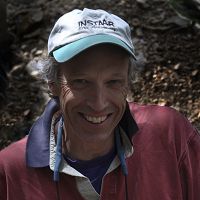Winchell, et al., 2015
Exploring the landscape evolution of the subalpine meadow-forest system driven by the geomorphic work performed by the Northern Pocket Gopher
Winchell, E., Anderson, R. S., Lombardi., E., and Doak, D. (2015)
EP41C-0936 Mechanistic Underpinnings of Damage, Disruption, and Downslope Transport of Rock and Regolith Posters, presented at 2015 Fall Meeting, AGU, San Francisco, CA, 14-18 Dec.
-
Boulder, GRAD STUDENT
-
Boulder, INVESTIGATOR
-
Boulder, INVESTIGATOR
Abstract
In the subalpine zone of the Colorado Front Range, field observations suggest that the Northern Pocket Gopher acts as a significant geomorphic agent within meadows, but not within forests. Field surveys during 2014 and 2015 demonstrate that the temporal and spatial digging patterns of gopher-excavated mounds and infilled tunnels are neither steady nor uniform. These include 1) gophers spend the winter near the forest-meadow (FM) edge and the remainder of the year within the meadow, and 2) surface mound generation greatly accelerates in late summer. Hourly subsurface temperatures across the FM pair, and daily digital snow depths at the FM boundary suggest that gophers spend the winter beneath thick snow cover where ground temperatures are warmest. LiDAR-based topography demonstrates that slopes are uniform across the FM pairs, diverging from that expected by extrapolation of the observed pattern of non-uniform geomorphic activity. The topography therefore suggests that the FM boundaries are not stationary. We hypothesize that the landscape is more uniformly impacted by gopher activity in the long term, which requires that 1) FM boundaries migrate significantly and/or 2) meadows are born in different places following forest death via fire followed by rapid gopher habitation.
The vertical geomorphic signature of gopher activity is more distinct. Preliminary probing of meadows reveals a 20 cm thick biomantle with a high concentration of stones at ~20 cm depth. The annual surface areas of mounds and infilled tunnels suggest that the entire meadow can be exposed to excavated tillings on century timescales. Further, annual mound volumes suggest that the biomantle is turned over also on century timescales. We will report results of stone line surveys and 137Cs concentration profiles within the forest and meadow that will test the long-term stability of meadows and the timescale over which vertical churning mixes the near-surface material within this landscape.
Citation
Winchell, E., Anderson, R. S., Lombardi., E., and Doak, D. (2015): Exploring the landscape evolution of the subalpine meadow-forest system driven by the geomorphic work performed by the Northern Pocket Gopher. EP41C-0936 Mechanistic Underpinnings of Damage, Disruption, and Downslope Transport of Rock and Regolith Posters, presented at 2015 Fall Meeting, AGU, San Francisco, CA, 14-18 Dec..
Explore Further


